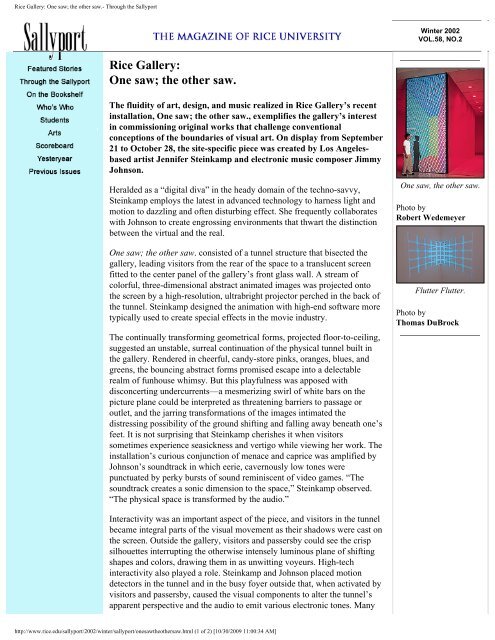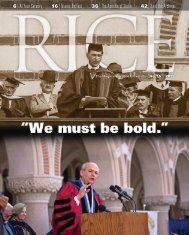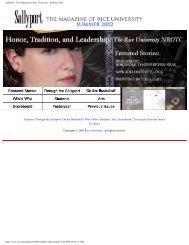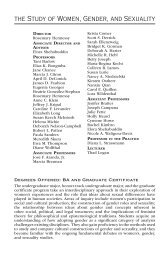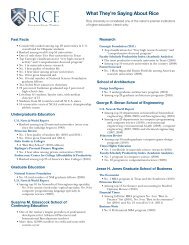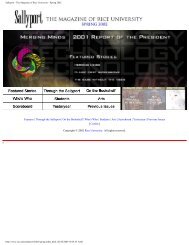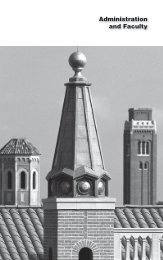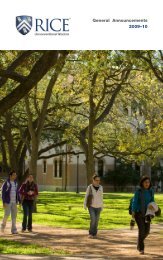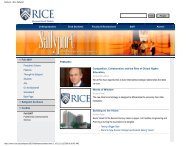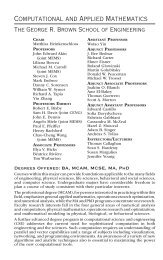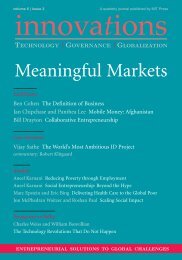Sallyport - The Magazine of Rice University - Winter 2002
Sallyport - The Magazine of Rice University - Winter 2002
Sallyport - The Magazine of Rice University - Winter 2002
You also want an ePaper? Increase the reach of your titles
YUMPU automatically turns print PDFs into web optimized ePapers that Google loves.
<strong>Rice</strong> Gallery: One saw; the other saw.- Through the <strong>Sallyport</strong><br />
<strong>Winter</strong> <strong>2002</strong><br />
VOL.58, NO.2<br />
<strong>Rice</strong> Gallery:<br />
One saw; the other saw.<br />
<strong>The</strong> fluidity <strong>of</strong> art, design, and music realized in <strong>Rice</strong> Gallery’s recent<br />
installation, One saw; the other saw., exemplifies the gallery’s interest<br />
in commissioning original works that challenge conventional<br />
conceptions <strong>of</strong> the boundaries <strong>of</strong> visual art. On display from September<br />
21 to October 28, the site-specific piece was created by Los Angelesbased<br />
artist Jennifer Steinkamp and electronic music composer Jimmy<br />
Johnson.<br />
Heralded as a “digital diva” in the heady domain <strong>of</strong> the techno-savvy,<br />
Steinkamp employs the latest in advanced technology to harness light and<br />
motion to dazzling and <strong>of</strong>ten disturbing effect. She frequently collaborates<br />
with Johnson to create engrossing environments that thwart the distinction<br />
between the virtual and the real.<br />
One saw; the other saw. consisted <strong>of</strong> a tunnel structure that bisected the<br />
gallery, leading visitors from the rear <strong>of</strong> the space to a translucent screen<br />
fitted to the center panel <strong>of</strong> the gallery’s front glass wall. A stream <strong>of</strong><br />
colorful, three-dimensional abstract animated images was projected onto<br />
the screen by a high-resolution, ultrabright projector perched in the back <strong>of</strong><br />
the tunnel. Steinkamp designed the animation with high-end s<strong>of</strong>tware more<br />
typically used to create special effects in the movie industry.<br />
<strong>The</strong> continually transforming geometrical forms, projected floor-to-ceiling,<br />
suggested an unstable, surreal continuation <strong>of</strong> the physical tunnel built in<br />
the gallery. Rendered in cheerful, candy-store pinks, oranges, blues, and<br />
greens, the bouncing abstract forms promised escape into a delectable<br />
realm <strong>of</strong> funhouse whimsy. But this playfulness was apposed with<br />
disconcerting undercurrents—a mesmerizing swirl <strong>of</strong> white bars on the<br />
picture plane could be interpreted as threatening barriers to passage or<br />
outlet, and the jarring transformations <strong>of</strong> the images intimated the<br />
distressing possibility <strong>of</strong> the ground shifting and falling away beneath one’s<br />
feet. It is not surprising that Steinkamp cherishes it when visitors<br />
sometimes experience seasickness and vertigo while viewing her work. <strong>The</strong><br />
installation’s curious conjunction <strong>of</strong> menace and caprice was amplified by<br />
Johnson’s soundtrack in which eerie, cavernously low tones were<br />
punctuated by perky bursts <strong>of</strong> sound reminiscent <strong>of</strong> video games. “<strong>The</strong><br />
soundtrack creates a sonic dimension to the space,” Steinkamp observed.<br />
“<strong>The</strong> physical space is transformed by the audio.”<br />
One saw, the other saw.<br />
Photo by<br />
Robert Wedemeyer<br />
Flutter Flutter.<br />
Photo by<br />
Thomas DuBrock<br />
Interactivity was an important aspect <strong>of</strong> the piece, and visitors in the tunnel<br />
became integral parts <strong>of</strong> the visual movement as their shadows were cast on<br />
the screen. Outside the gallery, visitors and passersby could see the crisp<br />
silhouettes interrupting the otherwise intensely luminous plane <strong>of</strong> shifting<br />
shapes and colors, drawing them in as unwitting voyeurs. High-tech<br />
interactivity also played a role. Steinkamp and Johnson placed motion<br />
detectors in the tunnel and in the busy foyer outside that, when activated by<br />
visitors and passersby, caused the visual components to alter the tunnel’s<br />
apparent perspective and the audio to emit various electronic tones. Many<br />
http://www.rice.edu/sallyport/<strong>2002</strong>/winter/sallyport/onesawtheothersaw.html (1 <strong>of</strong> 2) [10/30/2009 11:00:34 AM]


